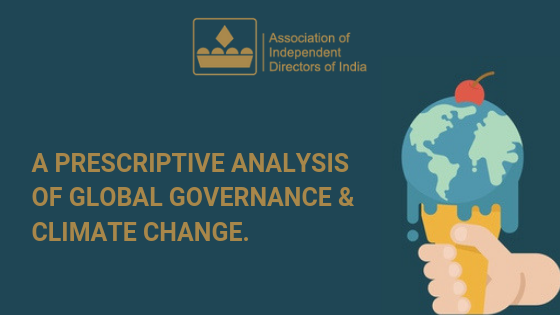With consistent transformations in climatic patterns around the globe, the human civilization has arrived to a point from where the road ahead is highly uncertain and ambiguous. Rising temperatures, reduced ice sheets, glacial retreats and increasing number of extreme events are all indications of an unprecedented state of emergency. Tackling this would require an approach where all nations unite as one to act towards climate change by means of a global policy framework on climate change.
ROLE OF INSTITUTIONS IN COMBATING CLIMATE CHANGE
The establishment of Intergovernmental Panel on Climate Change (IPCC) in 1991 and United Nations Framework Convention on Climate Change (UNFCCC) in 1994 have played a pivotal role in leading the charge towards guiding nations in a coherent direction with a collective goal of preserving the natural eco-system. A certain degree of advancement was made with the execution of global treaties like the Kyoto Protocol, but with the accumulation of more and more institutions and committees, the influence of their decisions went down the scale since multiple laws and regulations contradicted each other.
However, global governance on climate change now isn’t only confined to multilateral policies, and governments aren’t the only authority. Alongside, sits various other private and public committees, engaged in similar operations but with their own way of regulation. This can be viewed from a lens of optimism, where awareness is increasing and negating the purpose of multilateral-nation level agreements.
CLIMATE CHANGE AS A TEST CASE OF GLOBAL GOVERNANCE
The subject of Climate change was implemented as a test case for global governance since it is a matter of high priority and demands maximum worldwide attention. This unfolds in two fundamental ways:
- The perspective of drawing influence: This simply draws emphasis on whether international climate negotiations can learn enough from other models of global governance, regimes, or institutions, like trade negotiations, other multilateral environmental treaties, the governance of finance and money, and the governance of technology. There are lessons out there to be tapped into that the climate regime needs to pay attention to, including on how new technologies need to be developed, how intellectual property is developed and shared, how innovative finance is brought to bear on solving problems, how monitoring can be effective. Even though it might already be in action at the ground level, it is far from easy in its execution.
- Collective action approach: This deliberates on how a collective action is taken with the involvement of different actors, at different stages. If a collective action is formulated, a lot more can be recognized about climate change.
It would be fair to state that the issue of climate change has aggravated to an extent where it is now time for corporate entities and MNC’s to rise up and strike a difference by leading as flag bearers of change, because wherever the business flows, others follow. Corporate governance is now streamlined with climatic changes, for corporates are one of the main causes behind the ongoing state of flux on our planet.
CORPORATE’S ROLE: TIME TO TAKE ACCOUNTABILITY
Businesses, which possess the maximum potential to control climate change, should recognise their honest responsibilities and must not squirm from taking accountability. These entities produce just about everything we buy, use and dispose. They have set limits for greenhouse gases and some even control these emissions under those limits, but always fail to include in it, the emissions released by their products in their entire life cycle. In simpler terms, a significant amount of emissions are caused due to the wear and tear of a commodity during its use and disposal. According to a study, the top 15 U.S. food and beverage companies generate nearly 630 million metric tons of greenhouse gases every year, which makes this group of companies a larger emitter than Australia (15th largest annual source of greenhouse gases).
FROM TREES TO TOILET PAPER: AN EYE OPENER
Considering the case of American tissue companies, where P&G and some of its competitors are having a phenomenal share in depleting the world’s remaining forest cover. A report found that the use of virgin pulp in the production of their toilet paper, facial tissue, and paper towel brands is a major greenhouse gas source. In fact, with annual virgin pulp use at 1.5 million metric tons, P&G’s disposable paper, hygiene, and baby care products are estimated to generate 17.8 million metric tons of greenhouse gas emissions each year. That’s equivalent to the annual emissions of 3.8 million passenger vehicles, but P&G’s greenhouse gas reduction goal applies to only a tiny percentage of these emissions.
P&G’s climate commitment appears to be fairly progressive, but only on paper: reduce annual emissions to 50% by 2030, but the devil lies in the details, P&G’s commitment only applies to what are known in the corporate greenhouse gas accounting world as Scope1 and Scope 2 emissions. These are emissions generated by a corporation’s own facilities- factories, vehicles, power plants- and the emissions generated by third parties from whom the corporation buys energy. These emissions are easy for corporations to measure, and relatively easy for them to control but they’re just a fraction of the true impact of their operations.
It must be noted that such misleading practices directly impact the sustainability of the business. Seasoned Industry Experts have repeatedly suggested that corporations striving to innovate and introduce systems and processes that are environmentally sustainable, will be the ones who witness prosperous longevity.
Conclusion:
The clock has struck the hour of panic, creating an urgency to act before the problem blows out of proportion and becomes extremely unmanageable. A wave of activism, awareness and action must flow across the global corporate landscape to get things under control.

